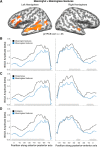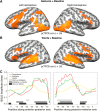The Large-Scale Organization of Gestures and Words in the Middle Temporal Gyrus
- PMID: 31126999
- PMCID: PMC6650980
- DOI: 10.1523/JNEUROSCI.2668-18.2019
The Large-Scale Organization of Gestures and Words in the Middle Temporal Gyrus
Abstract
The middle temporal gyrus (MTG) has been shown to be recruited during the processing of words, but also during the observation of actions. Here we investigated how information related to words and gestures is organized along the MTG. To this aim, we measured the BOLD response in the MTG to video clips of gestures and spoken words in 17 healthy human adults (male and female). Gestures consisted of videos of an actress performing object-use pantomimes (iconic representations of object-directed actions; e.g., playing guitar), emblems (conventional gestures, e.g., thumb up), and meaningless gestures. Word stimuli (verbs, nouns) consisted of video clips of the same actress pronouncing words. We found a stronger response to meaningful compared with meaningless gestures along the whole left and large portions of the right MTG. Importantly, we observed a gradient, with posterior regions responding more strongly to gestures (pantomimes and emblems) than words and anterior regions showing a stronger response to words than gestures. In an intermediate region in the left hemisphere, the response was significantly higher to words and emblems (i.e., items with a greater arbitrariness of the sign-to-meaning mapping) than to pantomimes. These results show that the large-scale organization of information in the MTG is driven by the input modality and may also reflect the arbitrariness of the relationship between sign and meaning.SIGNIFICANCE STATEMENT Here we investigated the organizing principle of information in the middle temporal gyrus, taking into consideration the input-modality and the arbitrariness of the relationship between a sign and its meaning. We compared the middle temporal gyrus response during the processing of pantomimes, emblems, and spoken words. We found that posterior regions responded more strongly to pantomimes and emblems than to words, whereas anterior regions responded more strongly to words than to pantomimes and emblems. In an intermediate region, only in the left hemisphere, words and emblems evoked a stronger response than pantomimes. Our results identify two organizing principles of neural representation: the modality of communication (gestural or verbal) and the (arbitrariness of the) relationship between sign and meanings.
Keywords: emblems; gestures; organization; pantomimes; speech.
Copyright © 2019 the authors.
Figures





Similar articles
-
A norming study of high-quality video clips of pantomimes, emblems, and meaningless gestures.Behav Res Methods. 2019 Dec;51(6):2817-2826. doi: 10.3758/s13428-018-1159-8. Behav Res Methods. 2019. PMID: 30542913 Free PMC article.
-
Differential roles for left inferior frontal and superior temporal cortex in multimodal integration of action and language.Neuroimage. 2009 Oct 1;47(4):1992-2004. doi: 10.1016/j.neuroimage.2009.05.066. Epub 2009 Jun 1. Neuroimage. 2009. PMID: 19497376
-
Brain-based translation: fMRI decoding of spoken words in bilinguals reveals language-independent semantic representations in anterior temporal lobe.J Neurosci. 2014 Jan 1;34(1):332-8. doi: 10.1523/JNEUROSCI.1302-13.2014. J Neurosci. 2014. PMID: 24381294 Free PMC article. Clinical Trial.
-
Hearing and seeing meaning in speech and gesture: insights from brain and behaviour.Philos Trans R Soc Lond B Biol Sci. 2014 Sep 19;369(1651):20130296. doi: 10.1098/rstb.2013.0296. Philos Trans R Soc Lond B Biol Sci. 2014. PMID: 25092664 Free PMC article. Review.
-
Alignment in Multimodal Interaction: An Integrative Framework.Cogn Sci. 2020 Nov;44(11):e12911. doi: 10.1111/cogs.12911. Cogn Sci. 2020. PMID: 33124090 Free PMC article. Review.
Cited by
-
The representational space of observed actions.Elife. 2019 Dec 5;8:e47686. doi: 10.7554/eLife.47686. Elife. 2019. PMID: 31804177 Free PMC article.
-
Distinct resting-state functional connectivity patterns of Anterior Insula affected by smoking in mild cognitive impairment.Brain Imaging Behav. 2023 Aug;17(4):386-394. doi: 10.1007/s11682-023-00766-6. Epub 2023 May 27. Brain Imaging Behav. 2023. PMID: 37243752 Free PMC article.
-
Integrated multimodal cell atlas of Alzheimer's disease.Nat Neurosci. 2024 Dec;27(12):2366-2383. doi: 10.1038/s41593-024-01774-5. Epub 2024 Oct 14. Nat Neurosci. 2024. PMID: 39402379 Free PMC article.
-
Expertise influences congruency monitoring during action observation at the motor level.Soc Cogn Affect Neurosci. 2021 Dec 30;16(12):1288-1298. doi: 10.1093/scan/nsab078. Soc Cogn Affect Neurosci. 2021. PMID: 34195838 Free PMC article.
-
Integrated multimodal cell atlas of Alzheimer's disease.Res Sq [Preprint]. 2023 May 23:rs.3.rs-2921860. doi: 10.21203/rs.3.rs-2921860/v1. Res Sq. 2023. Update in: Nat Neurosci. 2024 Dec;27(12):2366-2383. doi: 10.1038/s41593-024-01774-5. PMID: 37292694 Free PMC article. Updated. Preprint.
References
-
- Agostini B, Papeo L, Galusca CI, Lingnau A (2018) A norming study of high-quality video clips of pantomimes, emblems, and meaningless gestures. Behav Res Methods. Advance online publication. Retrieved December 12, 2018. doi: 10.3758/s13428-018-1159-8. 10.3758/s13428-018-1159-8 - DOI - DOI - PMC - PubMed
Publication types
MeSH terms
LinkOut - more resources
Full Text Sources
